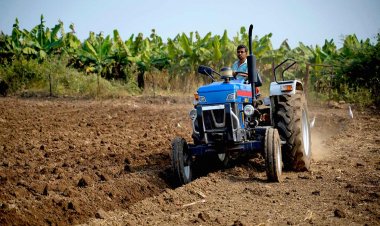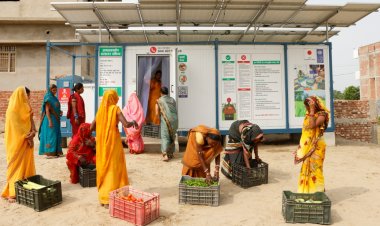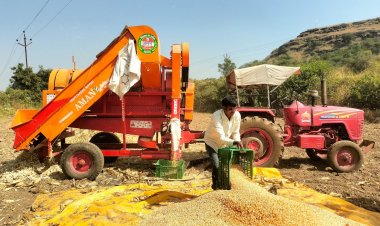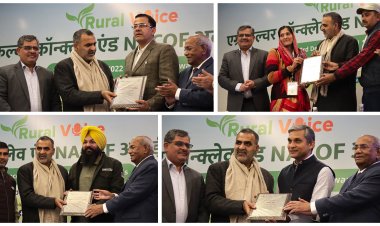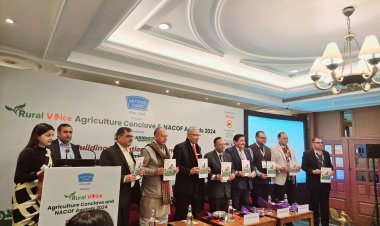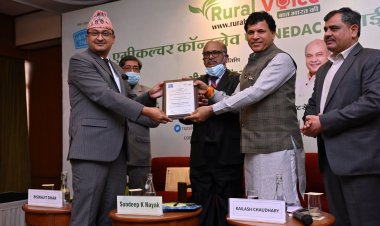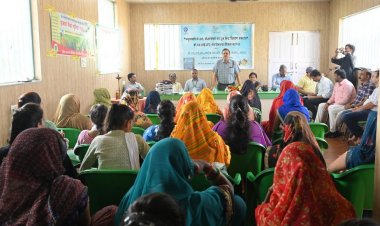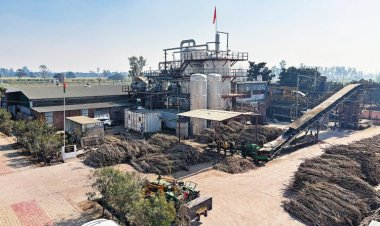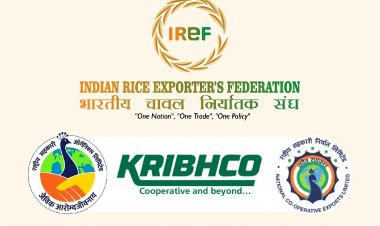Innovations for Transformation in Agri-Food Systems in the Amrit Kaal
The global agri-food system presently faces multiple challenges. Feeding a growing global population, estimated to reach 9.8 billion by 2050, would require significant increase in food production. This must be achieved while addressing the concerns on natural resource decline, climate change and the increased cost of production linked to reduced farm income.
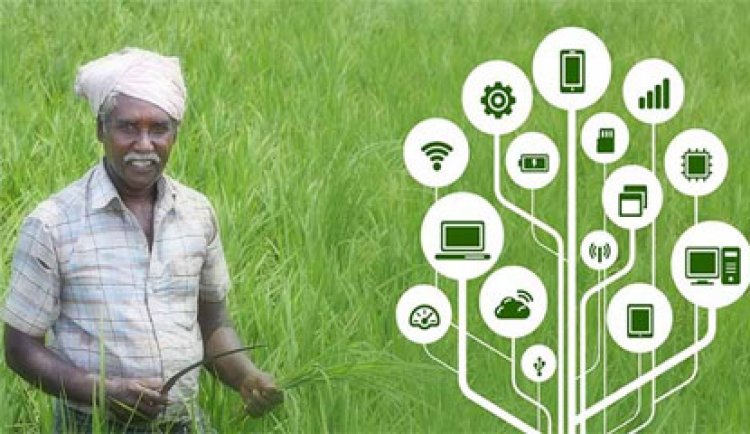
The global agri-food system presently faces multiple challenges. Feeding a growing global population, estimated to reach 9.8 billion by 2050, would require significant increase in food production. This must be achieved while addressing the concerns on natural resource decline, climate change and the increased cost of production linked to reduced farm income. The current agri-food system also struggles with inefficiencies and lack of unsustainable practices. Also, the smallholder farmers lack access to new technologies and resources. Additionally, prevailing agricultural practices are over-exploiting our natural resources, besides high levels of food waste and greenhouse gas emissions. Since COVID-19 Pandemic, there had also been further rise in poverty, whereas acute food shortages in 93 countries had further necessitated greater reliance on local food systems and regenerative agriculture, as highlighted by the UN Food Systems Summit. Hence, pressure now is to have resilience in agriculture while conserving natural resources, so as to ensure continued food security through local food systems.
Achieving Sustainable Development Goals (SDGs) by 2030 is another challenge that most nations have to address on priority. It is also evident that without India achieving these goals, meeting SDGs at the global level will be illusive. The Paris Agreement further necessitates the role of agriculture both for reducing the emission of greenhouse gas (GHG) and for carbon sequestration to a level of 3 billion tons of CO2 equivalent. These would, thus, demand better management of livestock, especially bovines, efficient use of fertilizers and reducing water use in crops like rice and sugarcane, etc. while improving soil health through regenerative agriculture, including conservation agriculture with major thrust on agroforestry adopting the practice of planting trees on each bund (Har Med Par Ped).
Hence, addressing the vicious circle of existing high population growth and poverty (16.4%), besides greater proportion of under-nourished children under 5 years of age (46%) will be the main priority in the Amrit Kal.
Thanks to Green Revolution in late sixties, we have been successful in increasing food grain production by six and half-fold (323.5 mt) as against four and half-fold increase in population. From net importing nation, India has emerged as a significant agriculture exporter fetching around US $ 55 billion annually. No doubt, these gains have come at the cost of adverse spill-over effects on natural resources, besides climate change. India also witnessed remarkable achievements in horticulture (341.5 mt), milk production (210 mt), and the fish production (14.2 mt). Also, the country's buffer stock of food grains reached to almost 95 mt by 2020, These impressive gains in agricultural output, productivity, and poverty reduction highlight India's remarkable progress towards food security and improved livelihood for millions of smallholder farmers. The cradles of success of different revolutions (green, white, blue, rainbow) include political will, institutions, human resource and partnerships, besides progressive farmers willing to invest and adopt new technologies.
While entering into Amrit Kal, we now need paradigm shifts from genetic enhancement to that of natural resource management and from agricultural research for development (AR4D) to agricultural research and innovation for development (ARI4D). Also for harnessing new science, policy support shall be needed to double the current investment on agricultural research, while scaling innovations such as genetically modified (GM) crops, genome/gene editing, bioinformatics, artificial intelligence, robotics, drones, mechanization, and conservation agriculture. Greater thrust will have to be now on post-production management through value chain and linking farmers to market (both internal and global). For faster delivery and adoption of new technologies, strengthening of Public-Private Partnership (PPP), while protecting intellectual property (IP) rights will accelerate the pace. Water-efficient practices like direct-seeded rice needing the herbicide tolerant varieties (Figure 1) will offer new opportunities.
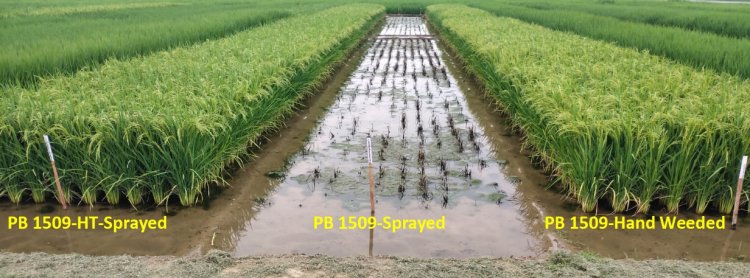
Figure 1. Herbicide tolerant (Ht) direct seeded basmati rice Photo: A K Singh, IARI
Those countries that have led greater focus on scaling of innovations have progressed. In this regard, we shall have to accelerate pace for new innovations and provide intellectual property (IP) regime for filing new patents in the field of agriculture. For example, in 2022, China had filed 1.58 million patents, compared to that of 505,539 in USA and 55, 718 in India. Success stories of maize and rice hybrids in the US and China, respectively, and Bt cotton in India demonstrate the potential of harnessing disruptive innovations for faster growth in agriculture. Therefore, we need now to think globally and act locally so as to replicate the successes elsewhere and move faster to excel where there is an opportunity. For example, the adoption of Bt cotton technology is a remarkable success story in India (Figure 2).
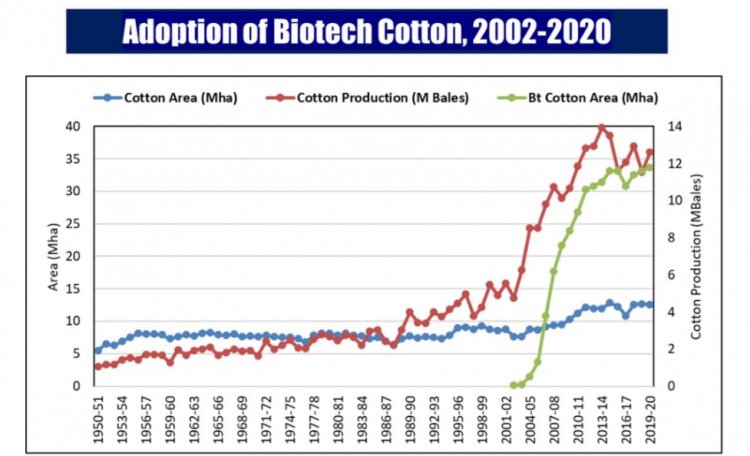
The cultivated area under Bt cotton has increased significantly, reaching from 7.0 to 12.0 mha. As a result, cotton production has almost doubled, rising from 2.3 mt to 4.0 mt in 2014. Notably, the use of pesticides has also reduced by 40 per cent, leading to substantial environmental and health benefits. In the process, income of around 5 million cotton farmers has increased by three-fold. Furthermore, India's cotton exports have been fetching over $4.0 billion annually, whereas before adoption of Bt cotton India was an importing country. Another example is that of single cross hybrid maize - the first single cross maize hybrid was released in 1995. These new hybrids, bred by both public and private sector, have helped in increasing the area from 6.0 to 10 mha, productivity from 1.0 to now 3.5 t/ha and production from 10.0 to 38.0 mt in 2022-23 i.e., just in last two decades (Figure 3).
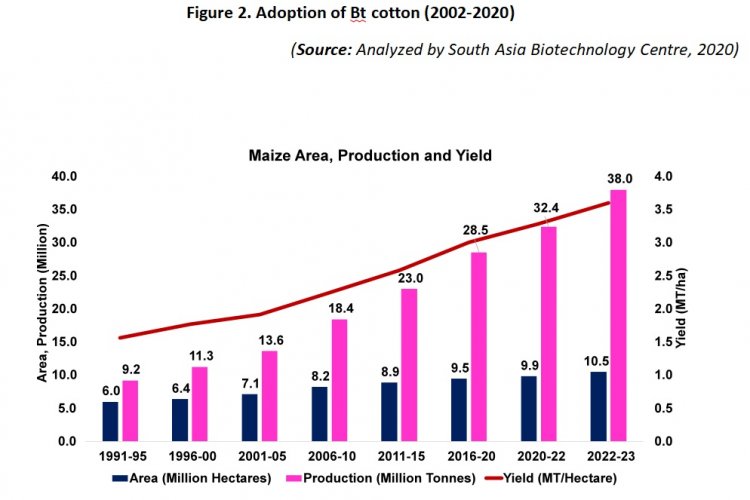
Also, the Innovations in natural resource management like conservation (no till) agriculture in dryland areas (still 45%), micro-irrigation, fertigation, biofertilizers, and waste to wealth, etc., offer enormous opportunities. The International Year of Millets (2023) underscored the importance of local food systems for future food security. In Amrit Kal, a wave of innovations and technological interventions is poised to transform agri-food systems, making them more productive, sustainable, and equitable (Figure 4). Innovations and technologies which are in vogue and need to be applied for improving production system are shown in Figure 4.
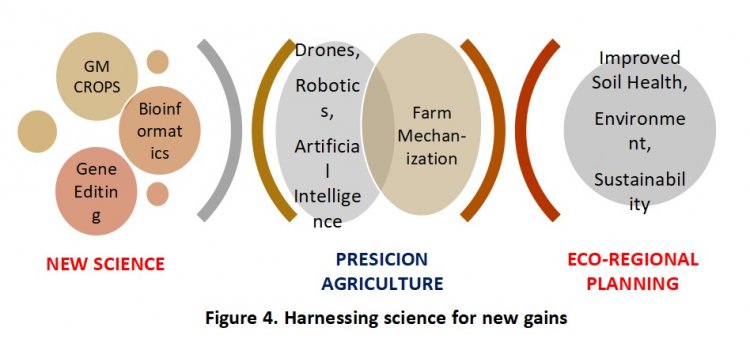
Innovations for Resilience in Agriculture
(i) Precision Farming: This approach utilizes data and technology for informed decision-making. Deploying sensor networks in fields to collect real-time data on soil moisture, nutrient levels, and crop health shall ensure optimizing irrigation, fertilizer application, and pest control, thereby maximizing yield and minimizing waste (Figure 5). In this context, the techniques like drone imagery and satellite data analyzed using artificial intelligence will provide insights into field variability, enabling farmers to optimize available resource use to improve yields. Affordable and accessible farm machinery for smallholder farmers will be the game-changer, especially when labour is now very costly.
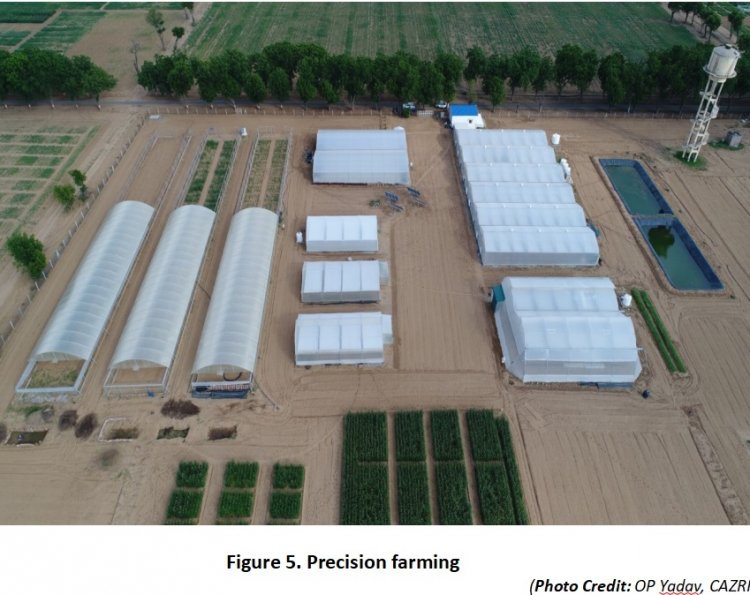
(ii) Agricultural Biotechnology: Emerging biotechnological tools such as genome/gene editing offer enormous potential for enhancing agricultural productivity as well as sustainability. These techniques shall hold promise for breeding varieties/hybrids that are more resistant to pests, diseases, biotic and abiotic stresses. Furthermore, biofortification shall enhance the nutritional content and address micronutrient deficiencies.
(iii) Vertical Farming and Controlled Environment Agriculture (CEA): Vertical farming and CEA represent a revolutionary approach to agriculture. They offer the potential to grow food more efficiently, sustainably, and in places previously thought to be unsuitable for farming like in urban areas with limited space, or even in harsh environments like deserts or areas with extreme climatic conditions. Vertical farms shall utilize stacked layers for growing crops indoors, minimizing land use and water requirements. CEA systems offer precise control over temperature, light, and humidity, thus optimizing the growth conditions for improved production.
Innovations for a Sustainable Production System
(i) Regenerative Agriculture: Unlike conventional practices that adversely affect the soil health over time, regenerative agriculture shall hold great promise for sustainable food production in future while mitigating climate challenge (Figure 6). The key practices under regenerative agriculture shall demand reorientation towards: cover cropping, reduced or no tillage (conservation agriculture), and composting, etc.
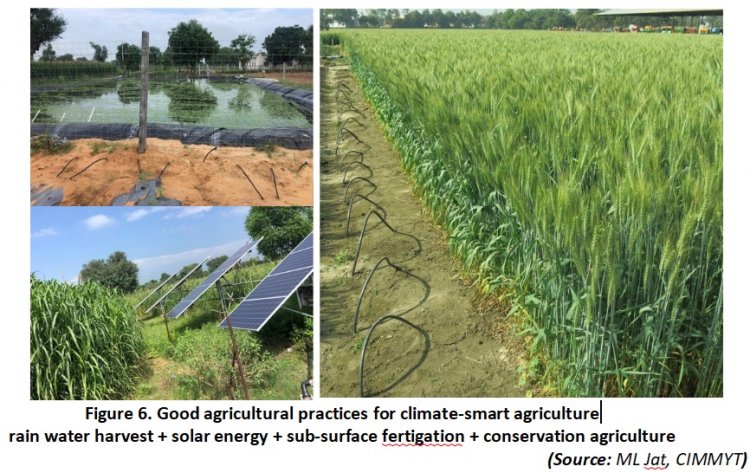
(ii) Circular Economy: Minimizing waste is crucial for a sustainable system. The circular economy approach represents a paradigm shift in agriculture. It is a win-win situation for the environment, economy, and food security by minimizing waste and maximizing resource use throughout the entire food production cycle. Food waste reduction strategies would urgently demand improved storage and transportation facilities, upcycling byproducts into valuable products, and developing efficient food waste management solutions like composting.
Innovations for Equitable Production System
(i) Digital Platforms and E-commerce: The digital revolution in agriculture has potential to empower smallholder farmers and create a more sustainable and equitable food system. As digital literacy and access to technology improve in rural areas, we can expect to see even greater positive impacts on the lives of smallholder farmers. Online platforms will connect farmers directly to consumers, eliminating intermediaries and increasing their profits. These platforms also provide access to market information, weather forecasts, and much needed agricultural advice, empowering thereby the smallholder farmers.
(ii) Financial Inclusion with a Focus on Smallholder Farmers: While challenges remain in terms of infrastructure and digital literacy in rural areas, the potential of blockchain to revolutionize financial inclusion for smallholder farmers is undeniable. As technology and access improve, we can expect to see a future where smallholder farmers will not just grow food, but also become successful businessmen. Blockchain technology shall revolutionize through easy access to credit for smallholder farmers. By creating secure and transparent financial records, blockchain facilitates microloans and financial services, enabling farmers to invest in new technologies and practices.
(iii) Knowledge Sharing and Capacity Building: As agricultural knowledge and technologies evolve, innovations in agricultural extension and their scaling would become critical. Including promotion of private extension, involving trained and skilled youth (including women) to disseminate both knowledge and services on custom hire basis. Farmers need to cope up with ever changing agricultural production systems.
Conclusions
While innovations hold immense potential for transforming our agri-food systems, challenges still remain ahead. Ensuring equitable access to technology and bridging the knowledge divide in rural areas for the welfare and enhanced income of smallholder farmers remains a challenge. Therefore, transforming the agri-food systems requires a multi-faceted approach. There is also an urgent need to achieve the SDGs and fulfill the commitments made under the Paris Agreement, as the time left now is short. Towards this, greater trust and investment in science, scaling new innovations, and adoption of secondary and specialty agriculture shall be urgently needed.
The emphasis must also shift towards a holistic approach to food systems, encompassing both production and post-production aspects. Building strong partnerships, such as public-private, between national agricultural research systems (NARS) and the international research centers – those under CGIAR and others will be vital. Motivating and attracting youth in agriculture (MAYA) will hold the key to major successes through entrepreneurship, production and supply of quality inputs, and private extension for sharing new knowledge and advisory. Also, for the informed decision-making, policy advocacy and public awareness through consistent efforts by neutral Think Tanks like Trust for Advancement of Agricultural Sciences (TAAS) and National Academy of Agricultural Sciences (NAAS) will be needed to ensure science-based policy decisions during the Amrit Kal.
Finally, to ensure future food, nutrition and environmental security, nurturing the present national agricultural research system and increased funding to a minimum of 1 per cent of the agricultural GDP will be key for raising at least US$ 1 trillion from agriculture sector to the targeted 5 trillion national economy. Agri-food systems during the Amrit Kaal thus hold the key for our national food security and the global leadership in agriculture.
(The writer is Padma Bhushan Awardee. He is Former Secretary, DARE & Director General, ICAR and Chairman, Trust for Advancement of Agricultural Sciences-TAAS)



 Join the RuralVoice whatsapp group
Join the RuralVoice whatsapp group


















